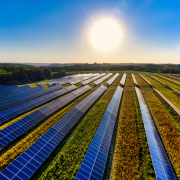AgriSolar News Roundup: The Power of Shade, Oregon Agrivoltaics Development, Agrivoltaics is a “Win-Win”
The Power of Shade in Agrivoltaics
“The sun’s energy feeds grazing fodder and crops side-by-side with solar panels. ‘For farmers, it’s a two-income stream,’ said Brad Heins, professor of animal science at the University of Minnesota. That might mean planting crops that thrive in the shade cast by the panels. Or, in Heins’ case, it can mean cooling cows in the panels’ shade rather than resorting to expensive fans in a barn.
Heins and his colleagues are at the cutting edge of this new field (agrivoltaics), but they aren’t alone. There are hundreds of agrivoltaics projects underway in the US. Some work better than others, and some may wind up not working at all. But the best will lead to a greener and more profitable rural America that embraces renewable energy as an asset.” – The Washington Post
Agrivoltaic Site Under Construction in Oregon
“Construction is underway on a $1.5 million project that will allow Oregon State University researchers to further optimize agrivoltaic systems that involve co-developing land for both solar photovoltaic power and agriculture. The five-acre Solar Harvest project is located at Oregon State’s North Willamette Research and Extension Center in Aurora, Oregon, 20 miles south of Portland. It is the result of a partnership between Oregon State and the Oregon Clean Power Cooperative.
The problem with agrivoltaics research to date, Higgins said, is that it has occurred using solar arrays designed strictly for electricity generation rather than in combination with agricultural uses, such as growing crops or grazing animals. The solar array at the North Willamette Research and Extension Center is designed specifically for agrivoltaics research, with panels that are more spread out and able to rotate to a near vertical position to allow farm equipment to pass through, Higgins said.” – Oregon State University
Agrivoltaics is Shown to be a “Win-Win” for Food and Energy
“’With the right investment, innovation and robust collaboration, agrifood systems could become one of the world’s most hopeful solutions to climate change, as well as reduce poverty and provide nourishment for all,’ says Sean de Cleene, head of the Food Systems Initiative at the World Economic Forum (WEF).
‘The hallmark characteristic of agrivoltaics is the sharing of sunlight between the two energy conversion systems: photovoltaics and photosynthesis,’ says Jordan Macknick, lead energy-water-land analyst at the US National Renewable Energy Laboratory. ‘It essentially mimics what humans have been doing for hundreds of years with agroforestry – think shade-grown coffee – intentionally creating partial shade to create multiple layers of agricultural productivity on the same piece of land.’” – Energy Monitor



